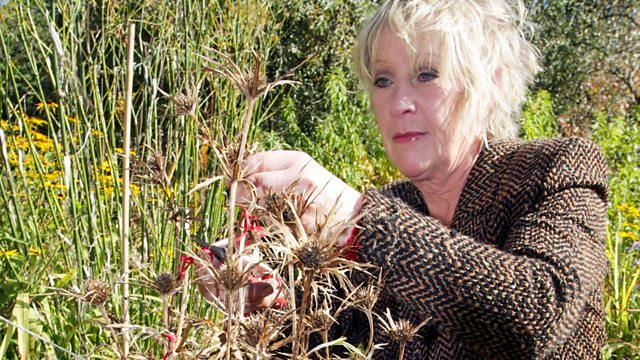Life in a Cottage Garden with Carol Kleine episode 6 – Into Winter: In November and December, the first frosts have struck. It’s time to put away tender perennials, begin judicious cutting-back and sweep up the fallen leaves.
The garden is laid bare, but beauty is still found in the skeletal structures of fading plants. Holly, box and yew reveal their evergreen glory and the perfume of viburnum and mahonia tempt insects still bravely on the wing. In the woodland garden, under the leaf-litter, the first snowdrops are already beginning to appear. As Carol plants her tulip bulbs, thoughts turn to spring.
Life in a Cottage Garden with Carol Kleine episode 6 – Into Winter
Three-season viburnums
In today’s smaller gardens, shrubs that perform at more than one season of the year are invaluable. The undisputed champions for colourful flowers, fruits and autumn foliage – are viburnums. Viburnums come in an enormous range of shapes and sizes, from small evergreens to large deciduous shrubs. Some are Far Eastern exotics (yet surprisingly hardy) whereas others come from our native British hedgerows.
The guelder rose, Viburnum opulus, features pretty white lacecap flowers in June and July, followed in autumn by glistening red berries that usually last well into the winter and that are accompanied for a few weeks by purplish or reddish autumn leaf colour. The berries of the yellow-berried ‘Xanthocarpum’ often stand out especially well while ‘Compactum’ has the benefit of a neater habit. But be aware that ‘Roseum’ is sterile – so no berries.
From across the Atlantic come a number of excellent three-season species. The rarely seen V. acerifolium has fluffy white flowers, red berries that mature to black, and plummy crimson autumn colour, while selections are being made of V. dentatum with its white late spring flowers, and rich blue-black berries that ripen with the fiery autumn foliage. Look out for the compact Blue Muffin (‘Christom’), with intensely blue berries.
Mahonia
Easily taken for granted, these tough, spiny-leaved evergreen shrubs have a number of garden uses. Some are good for covering the ground while others are imposing subjects for the back of a border. With shiny leaves, these boldly upright, squat or spreading shrubs have impressive clusters or spikes of fragrant, bright yellow flowers in winter to early spring, followed by juicy-looking purple to black berries in autumn.
Moist soils that drain well are suitable, preferably in light shade, though full sun and deep shade are tolerated. Larger types dislike exposure to cold winds, which can scorch the foliage.
